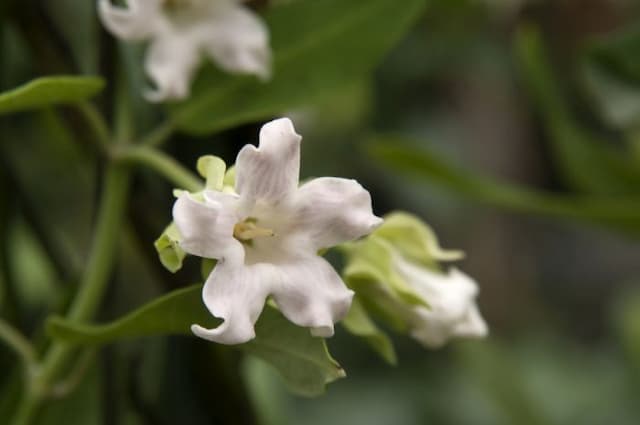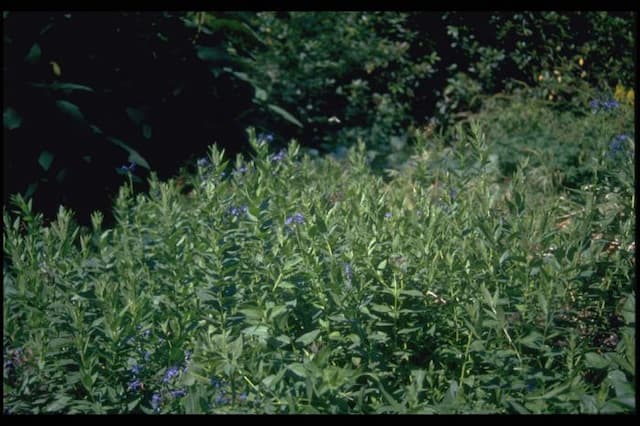Madagascar Palm Pachypodium lamerei

ABOUT
Pachypodium lamerei, commonly known as Madagascar palm, despite its name, is not a true palm. This plant is characterized by a thick, spiny gray trunk which serves as a water reservoir in dry climates. The trunk is covered in sharp, needle-like spines arranged in circular patterns. Atop the trunk, there is a crown of long, slender leaves that are glossy and green, giving the plant a palm-like appearance. These leaves generally grow in a tuft at the top of the trunk, which can give it a somewhat tropical look, despite its ability to withstand arid conditions. The Madagascar palm produces flowers under the right conditions, which are typically large, star-shaped, and can vary from white to creamy-yellow in color, adding a decorative element to its already intriguing form. However, it is important to note that flowering is often rare when the plant is kept indoors. Overall, the Madagascar palm has a distinctive and striking appearance, being both robust and elegant, and is often grown as an ornamental plant due to its unique looks.
About this plant
 Names
NamesFamily
Apocynaceae
Synonyms
Madagascar Palm, Club Foot
Common names
Pachypodium lamerei var. ramosum, Pachypodium ramosum.
 Toxicity
ToxicityTo humans
The Madagascar palm, Pachypodium lamerei, contains toxic alkaloids. If ingested, parts of the plant, particularly the sap, can cause symptoms like nausea, vomiting, and diarrhea. In severe cases, ingesting parts of the Madagascar palm can lead to more serious effects such as arrhythmias, increased heart rate, and possibly seizures. Care should be taken to avoid consuming any part of this plant.
To pets
The Madagascar palm is also toxic to pets due to the presence of alkaloids. If pets ingest any part of the plant, especially the sap, they could experience vomiting, diarrhea, lethargy, and in worse cases, could have seizures. It is important to prevent pets from chewing on or ingesting any part of the Madagascar palm to avoid these potential health issues.
 Characteristics
CharacteristicsLife cycle
Perennials
Foliage type
Deciduous
Color of leaves
Green
Flower color
White
Height
6 feet (1.83 meters)
Spread
2 feet (0.61 meters)
Plant type
Succulent
Hardiness zones
10
Native area
Madagascar
Benefits
 General Benefits
General Benefits- Ease of Care: Pachypodium lamerei, commonly known as Madagascar Palm, is relatively easy to care for, requiring minimal watering and capable of surviving neglect.
- Drought Tolerance: This plant is highly drought-tolerant, making it ideal for arid climates and water-wise gardens.
- Architectural Interest: With its thick, spiny trunk and lush, green leaves at the top, the Madagascar Palm adds a striking architectural element to any landscape or indoor space.
- Low Pest and Disease Risk: It is not commonly afflicted by pests or diseases, which is a benefit for garden maintenance.
- Suitable for Containers: Madagascar Palm can be grown in pots, which makes it versatile for indoor décor or outdoor spaces with limited ground soil.
- Attracts Pollinators: When in bloom, its flowers can attract pollinating insects, which is beneficial for the garden ecosystem.
- Longevity: As a slow-growing plant, the Madagascar Palm can live for many years with the proper care, providing a long-term feature for spaces.
 Medical Properties
Medical PropertiesThis plant is not used for medical purposes.
 Air-purifying Qualities
Air-purifying QualitiesThis plant is not specifically known for air purifying qualities.
 Other Uses
Other Uses- Pachypodium lamerei, commonly known as Madagascar palm, can be used as a natural fence due to its spiny trunk which can deter animals and unauthorized entry.
- Its thick, succulent stem has the capability to store water, making slices of the stem an emergency water source in arid regions.
- The striking appearance of the Madagascar palm makes it a popular choice for bonsai cultivation, providing an exotic aesthetic to enthusiasts.
- The white, fragrant flowers of the plant are sometimes used in traditional ceremonies and decorations in its native habitat.
- Dried stems of the Madagascar palm can be carved into curious ornaments and decorative pieces for artistic purposes.
- The tree's unique form is often integrated into landscape architecture as an architectural focal point in gardens and parks.
- The resilient nature of the Madagascar palm allows it to be used in reforestation efforts in areas with harsh growing conditions.
- Its tall and distinct silhouette serves as a natural windbreak, protecting more delicate plants in garden arrangements.
- In its native Madagascar, the fibrous parts of the plant have been utilized for crafting ropes and other woven materials.
- The long, straight trunks are sometimes repurposed as poles for construction or fencing once the tree has died and dried out.
Interesting Facts
 Feng Shui
Feng ShuiThe Madagascar palm is not used in Feng Shui practice.
 Zodiac Sign Compitability
Zodiac Sign CompitabilityThe Madagascar palm is not used in astrology practice.
 Plant Symbolism
Plant Symbolism- Resilience: Pachypodium lamerei, commonly known as Madagascar Palm, has adapted to survive in harsh, arid environments. Its thick stem stores water, symbolizing the ability to endure and thrive even in difficult conditions.
- Protection: The Madagascar Palm's spiny exterior serves as protection against herbivores. Symbolically, this can represent a need for defense or guarding one's personal space and boundaries.
- Beauty and danger: With its beautiful flowers and sharp spines, this plant embodies the juxtaposition of beauty and danger, reminding us that sometimes, attractive appearances can mask underlying risks.
- Adaptability: As a plant that grows well in various types of soil and in indoor environments, the Madagascar Palm symbolizes the ability to adapt to different circumstances and environments.
 Water
WaterThe Madagascar palm, also known commercially as Pachypodium lamerei, should be watered sparingly. During the growing season in spring and summer, it’s important to let the soil dry out completely between waterings. Typically, watering once every two weeks with about 8 to 12 ounces of water is sufficient. In the colder months, reduce watering frequency to once a month, as the plant will be in a dormant state. Overwatering can lead to root rot, so ensuring proper drainage is also crucial.
 Light
LightThe Madagascar palm thrives in full sunlight. It prefers a south-facing location where it can receive at least six hours of direct sun daily. Ensure the plant is not shaded by other plants or structures to maintain healthy growth. During the winter months, if indoors, place the Madagascar palm near a window where it continues to receive as much sunlight as possible.
 Temperature
TemperatureThe Madagascar palm prefers warm temperatures and does not tolerate cold well. It thrives in a temperature range of 60 to 85 degrees Fahrenheit. Keep the plant in temperatures above 50 degrees Fahrenheit to prevent cold damage. Ideally, providing a consistent temperature above 70 degrees Fahrenheit will foster the best growth and health of the plant.
 Pruning
PruningPruning the Madagascar palm should be done to remove any dead or damaged branches to maintain its appearance and health. This can be done in the spring as new growth appears. Pruning is typically not required frequently, possibly every couple of years, unless there is noticeable damage or parts that are diseased. Always use clean, sharp pruning shears to make precise cuts.
 Cleaning
CleaningAs needed
 Soil
SoilThe Madagascar palm prefers a well-draining cactus or succulent potting mix with added perlite or sand to enhance drainage. A soil pH between 6.0 and 7.5 is ideal.
 Repotting
RepottingThe Madagascar palm should be repotted every 2 to 3 years to refresh the soil and accommodate the growing roots.
 Humidity & Misting
Humidity & MistingThe Madagascar palm thrives in dry conditions and is tolerant of low humidity levels, making it suitable for typical indoor environments.
 Suitable locations
Suitable locationsIndoor
Place in bright light, minimal water in winter, repot every 2-3 years.
Outdoor
Full sun, protect from frost, well-draining soil mix.
Hardiness zone
9-11 USDA
 Life cycle
Life cycleThe Madagascar Palm (Pachypodium lamerei) life cycle begins with seed germination, which requires warm temperatures and usually occurs during the spring. Following germination, the seedling stage is characterized by the growth of a small rosette of leaves at the tip of a succulent stem as the plant establishes its root system. The juvenile stage involves the elongation of the trunk and continued development of leaves, with the plant starting to exhibit its characteristic thick, spiny trunk. As it reaches maturity, the Madagascar Palm develops a swollen, water-storing trunk and may produce its first flowers, typically white or cream-colored, when it is several years old, usually triggered by the dry season in its native habitat. During the reproductive stage, the tree produces seeds within the fruits after pollination, ensuring the propagation of the next generation. Lastly, the plant may enter a period of dormancy during colder or drier conditions, shedding leaves to conserve resources, before resuming growth when favorable conditions return.
 Propogation
PropogationPropogation time
Spring to Summer
Propogation: For the Madagascar Palm (Pachypodium lamerei), the most popular method of propagation is by seeds, typically sown in the spring or early summer when temperatures are warm. To propagate by seeds, one should first soak the seeds for several hours in warm water to help soften the seed coat and promote germination. Afterwards, the seeds can be sown in a well-draining cactus or succulent potting mix, lightly covered with soil, and kept moist. It is crucial to maintain a consistent temperature of around 70 to 85 degrees Fahrenheit (21 to 29 degrees Celsius). Seedlings usually appear within a few weeks and are generally slow-growing. As they develop, it's important to provide them with bright light and to be cautious with watering, allowing the soil to dry out between waterings to prevent rot.









